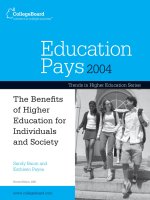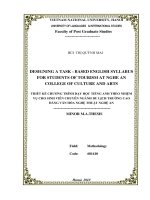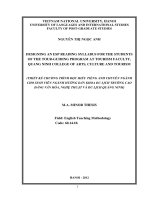Culture and society
Bạn đang xem bản rút gọn của tài liệu. Xem và tải ngay bản đầy đủ của tài liệu tại đây (117.56 KB, 8 trang )
Nguyễn Thị Ngọc Ngà
Văn Hóa Và Xã Hội
Culture and Society
Family Life: In Viet Nam’s traditional society, a
typical family has three or four generations living
under the same roof. With the view of "more
children, more fortunes", many families want to
have lots of children and grandchildren.
Influenced by Confucianism and the feudal view
of male preference, men play the most important
roles in family and always have final say. Feudal
ethics shape women around “three obediences,
four virtues” (three obediences: obedience to their
fathers during childhood, to their husbands when
married and to their sons in widowhood; four
virtues: diligence, good manner, proper speech,
and
morality)
Since reunification, the State of Viet Nam has
adopted a number of legal documents, notably
Law on Marriage and Family, in order to make
family relations more equal. Different measures
have also been taken to raise the awareness of the
public and change the obsolete attitude, ensure
gender equality and fight for the legitimate rights
of
women.
Today, Vietnamese family size tends to be
narrowed down to two or three generations. Most
couples have only two children. The advocacy for
men's superiority over women is weakening and
gradually being eliminated. However, the timehonoured tradition of "respect for the elderly and
love for the children" has been maintained and
advocated in each and every Vietnamese family.
Costume: Most ethnic groups in Viet Nam have
their own costumes that reflect their unique
cultural identities. Most of these costumes are
decorated with vivid patterns in contrast colours:
black-white, black-red, green-red or green-white
and made of natural fiber such as ramie, silk,
pineapple yarn or cotton. These materials are fine,
durable and sweat-absorbing, suitable for tropical
climate. The traditional costume of Vietnamese
men was white pants, brown tops with scarf and
ordinary sandals or wooden clogs called "guoc".
The official costume for men includes velvet or
cotton long dress and turban. For women,
costumes are more complicated and colourful
1
Cuộc sống gia đình: Trong xã hội truyền thống
của Việt Nam, một gia đình điển hình có ba hoặc
bốn thế hệ sống dưới cùng một mái nhà. Với quan
điểm "càng đông con, càng nhiều vận may", nhiều
gia đình muốn có nhiều con cháu. Chịu ảnh hưởng
của Nho giáo và quan điểm phong kiến ưu tiên
nam, người đàn ông là người đóng vai trò quan
trọng nhất trong gia đình và luôn luôn có tiếng nói
cuối cùng. Quan niệm đạo đức thời phong kiến đối
với người phụ nữ là " tam tòng, tứ đức " ( tam
tòng là “Tại gia tòng phụ, xuất giá tòng phu, phu
tử tòng tử”, tứ đức “Công - Dung - Ngôn - Hạnh”
)
Kể từ khi thống nhất đất nước, Nhà nước Việt
Nam đã thông qua một số văn bản pháp luật, đặc
biệt là Luật Hôn nhân và gia đình, để làm cho mối
quan hệ gia đình bình đẳng hơn. Các biện pháp
khác nhau cũng đã được thực hiện để nâng cao
nhận thức của công chúng và thay đổi chế độ lỗi
thời, đảm bảo bình đẳng giới và đấu tranh cho
quyền lợi chính đáng của người phụ nữ.
Ngày nay, kích thước gia đình Việt Nam có xu
hướng bị thu hẹp xuống đến hai hoặc ba thế hệ .
Hầu hết các cặp vợ chồng chỉ có hai con. Các
chính sách ưu tiên nam giới hơn phụ nữ đang yếu
dần và dần dần được loại bỏ. Tuy nhiên, truyền
thống lâu đời "tôn trọng người cao tuổi và yêu
thương trẻ em " đã được duy trì và ủng hộ trong
mỗi gia đình Việt Nam .
Trang phục: Hầu hết các nhóm dân tộc ở Việt
Nam có trang phục riêng của họ, phản ánh bản sắc
văn hóa độc đáo. Hầu hết các trang phục được
trang trí với những hoa văn sinh động màu sắc
tương phản: đen - trắng, đen - đỏ, xanh lá cây màu
đỏ hoặc màu xanh lá cây - trắng và làm từ sợi tự
nhiên như gai , tơ tằm, sợi dứa hoặc bông. Những
chất liệu này tốt, bền và hấp thụ mồ hôi, thích hợp
với khí hậu nhiệt đới. Trang phục truyền thống
của người đàn ông Việt Nam là quần trắng, áo
màu nâu với khăn choàng và dép quai hậu hoặc
đôi guốc gỗ được gọi là " guốc ". Trang phục
chính thức cho nam giới bao gồm áo dài bằng gấm
hay lụa và khăn xếp đội đầu. Đối với phụ nữ,
trang phục phức tạp hơn và nhiều màu sắc với
chiếc váy đen, yếm trắng, váy áo tứ thân với cái
with black skirt, white brassieres, four-panel dress
with "crow-beak" scarf and pergularia-like belt.
The official costume includes three layers of
dress. The first one is the velvet four-panel dress
in dark colour or light brown, then a light yellow
dress underneath and a lotus-colored one.
Wearing this costume, the woman only fastens the
buttons below her underarms, and the upper part
is opened to show the three colours of their
dresses. Beneath these three dresses is a red
brassiere. They wear a special large conical hat
called "non", which gives them an elegant look
and makes Vietnamese women more graceful.
Today, the official costumes of the Vietnamese
people have changed. Suits have replaced the
traditional costume of Vietnamese men. The long
dress or Ao Dai, which was first worn under Lord
Nguyen Phuc Khoat's regime, has been modified
to better suit Vietnamese women and is used in
many important ceremonies of the year. The
modern Ao Dai is a tunic slit to the waist with the
two loose panels falling down to mid shin. This
dress, which is really suitable to the small build of
a Vietnamese woman, reveals the hidden beautiful
curves
of
her
body.
Currently, with increasing exchanges among
different cultures, Vietnamese clothing becomes
more diverse and fashionable, reflecting a higher
level of integration, especially that of urban
youth.
Major Festivals: Festivals are typical folklore
cultural activities in all regions of Viet Nam. Such
festivals bring peace to the heart and mind of the
Vietnamese people, wipe out their pressures from
daily life, and bring them closer to nature and the
motherland. As an agricultural country, most
Vietnamese festivals are held during “leisure
times”, which are spring and autumn. There are
also national festivals for all Vietnamese people,
including the Lunar New Year (Tet Nguyen Dan),
July Full-Moon, August Full-Moon or Hung
Kings
Festival.
Lunar New Year (Tet Nguyen Dan-usually in late
January or early February): Lunar New Year is
the biggest one among Vietnam’s traditional
festivals. This is the time for family to get
together and enjoy traditional food, visit relatives,
friends and colleagues and wish them a happy
2
khăn " mỏ quạ " và dây thắt lưng. Trang phục
chính thức bao gồm ba lớp áo. Lớp đầu tiên là áo
tứ thân màu tối hoặc nâu nhạt, tiếp theo là một
chiếc áo lấp lánh kim tuyến vàng bên dưới là một
bông hoa sen màu. Mặc trang phục này, người phụ
nữ chỉ thắt nút dưới cánh tay của mình và phần
trên được hở ra để hiển thị ba màu sắc của trang
phục. lớp trong cùng của 3 trang phục là một cái
yếm đỏ. Họ đội cái nón quai thao đặc biệt gọi là "
nón " , mang lại cho họ một cái nhìn thanh lịch và
làm cho phụ nữ Việt Nam duyên dáng hơn .
Ngày nay, trang phục truyền thống của người Việt
Nam đã thay đổi. Các bộ quần áo đã thay thế các
trang phục truyền thống của người Việt Nam. Áo
dài, lần đầu tiên được mặc dưới chế độ vua chúa
Nguyễn Phúc Khoát, đã được sửa đổi tôt nhất để
phù hợp với phụ nữ Việt Nam và được sử dụng
trong nhiều nghi lễ quan trọng trong năm. Áo Dài
hiện đại là một vạt áo dài đến thắt lưng với hai tà
áo buông lỏng dọc theo phương. Trang phục này
thực sự thích hợp để tạo nên hình dáng bé nhỏ của
một người phụ nữ Việt Nam, nó tiết lộ những
đường cong đẹp tiềm ẩn của cơ thể của người phụ
nữ.
Hiện nay, với sự gia tăng giao lưu giữa các nền
văn hóa khác nhau, quần áo Việt Nam trở nên đa
dạng và thời trang hơn, phản ánh một mức độ cao
hơn của hội nhập, đặc biệt là giới trẻ thành thị.
Những lễ hội chính: Các lễ hội này là hoạt động
văn hóa dân gian điển hình trong tất cả các vùng
của Việt Nam. Lễ hội đem lại sự bình yên cho tâm
hồn và trí tuệ của người Việt Nam, xóa bỏ những
sức ép từ cuộc sống hàng ngày, và đưa họ gần gũi
hơn với thiên nhiên và quê hương. Là một nước
nông nghiệp, hầu hết các lễ hội Việt Nam được tổ
chức trong "thời gian nghỉ ", đó là mùa xuân và
mùa thu. Ngoài ra còn có các lễ hội truyền thống
cho tất cả người dân Việt Nam, trong đó có Tết
Âm Lịch ( còn gọi là Tết Nguyên Đán ), Rằm
Tháng 7, Rằm tháng 8 hay lễ hội về các vua Hùng.
Tết Âm Lịch (hay Tết Nguyên Đán, thường vào
cuối tháng Giêng hoặc đầu tháng Hai ): Tết Âm
Lịch là một trong những lễ hội truyền thống lớn
nhất trong số những lễ hội ở Việt Nam. Đây là
thời điểm cho gia đình gặp mặt nhau và thưởng
thức những món ăn truyền thống, thăm người
thân, bạn bè và đồng nghiệp và chúc họ một năm
mới hạnh phúc. Theo cảm nhận của tất cả mọi
người, Tết là sự kết thúc của năm cũ, tổng kết
những điều không may mắn để mở ra một năm
new year. As perceived by all people, Tet is the
end of the old year, the wrap-up of misfortunes to
open up a new year of good opportunities. The
New Year Eve is the most sacred moment when
all family members worship and pay tribute to
gods and ancestors. Apart from the New Year Eve
worshiping, other traditional rites such as "the
first visitor of the Year", "buds picking" and
"lucky money" are still practiced today.
Vu Lan Festival (July Full-Moon Festival): Vu
Lan Festival is dedicated to the deceased parents,
grandparents, and ancestors - an honored tradition
that reflects the "when eating fruit, remember who
planted the tree". According to Buddhism, on this
day, spirits of the dead come to the living world to
enjoy offerings. Most families hold worshiping
rites for ancestors. Upon the end of the rite, votive
papers are burnt for spirits of the dead. July FullMoon Festival is also the dead pardoning day or
worshiping the souls of the dead. Offerings are
parched rice, dry pancake, candies and fruits to
worship for wandering spirits, who are not
worshiped
by
relatives.
August Full-Moon Festival (Mid-Autumn
Festival): Mid-Autumn Festival (aka Moon
Watching Festival) is dedicated to children who
are very excited about the Festival as presents will
be sent out like star lanterns, masks, baked rice
cake, etc. On the night of the Festival, most
families have a tray of specialties for members to
get around and enjoy the Moon's beauty. The
specialties are mainly fruits and confectionery
formed like animals. The atmosphere of the
festival night is enjoyable with the laughter and
songs of children, the light of the Moon, lanterns,
and candles of many kinds. Games are also
available in many places such as Lantern Carrying
Dance, Lion and Dragon Dance, etc.
Hung Kings Worshipping Festival: March 10th of
the Lunar Calendar is the day of Hung Kings
National Worshipping Festival. This event is
celebrated everywhere in the country and abroad
where there are large Vietnamese communities.
The major celebration is held in Phu Tho, the first
capital of Viet Nam under Van Lang Dynasty and
the location of the Temple for 18 Hung Kings.
During this event, traditional offerings are
3
mới với những cơ hội tốt. Đêm Giao Thừa năm
mới là thời điểm thiêng liêng nhất khi tất cả các
thành viên trong gia đình thờ cúng và tôn vinh các
vị thần linh và tổ tiên. Bên cạnh thờ cúng Đêm
Giao Thừa, còn có những nghi lễ truyền thống
khác như " xông nhà" , " hái lộc " và " tiền may
mắn" vẫn còn diễn ra đến ngày hôm nay.
Lễ hội Vu Lan (là lễ hội diễn ra vào rằm tháng7):
Lễ hội Vu Lan được dành riêng cho các bậc cha
mẹ đã qua đời, ông bà, và tổ tiên – tôn vinh một
truyền thống " ăn quả nhớ kẻ trồng cây ". Theo
Phật giáo, vào ngày này, tinh thần của người chết
ở thế giới bên kia được đáp ứng. Hầu hết các gia
đình tổ chức các nghi lễ thờ cúng tổ tiên. Sau khi
kết thúc nghi lễ, vàng mã được đốt cho linh hồn
của người chết. Rằm Tháng 7 cũng là ngày tha lỗi
cho người chết hoặc thờ những linh hồn của người
chết. Những lễ vật là lúa mạch, bánh, bánh kẹo và
hoa quả để thờ cho những linh hồn lang thang,
những người không được thờ cúng bởi người thân.
Lễ hội trăng tròn tháng 8 ( hay còn gọi là Tết
Trung Thu ) : Lễ hội Trung thu ( hay còn gọi là
Hội trông trăng) được dành riêng cho trẻ em đang
rất hào hứng về các lễ hội như những món quà sẽ
được gửi đến như lồng đèn ngôi sao, mặt nạ, bánh
nướng, vv.
Trong đêm lễ hội, hầu hết các gia đình có bày một
mâm ngũ quả cho các thành viên và ngồi xung
quanh, cùng nhau tận hưởng vẻ đẹp của mặt trăng.
Đặc sản chủ yếu là trái cây và bánh kẹo được tạo
thành như những con vật. Không khí ban đêm lễ
hội cùng với những tiếng cười và những bài hát
của trẻ em, ánh sáng của mặt trăng, đèn lồng, và
nến của nhiều loại thật thú vị. Những trò chơi
cũng có sẵn ở nhiều nơi như đèn lồng, múa Sư Tử
và múa Lân , vv…
Lễ Hội Thờ Cúng Các Vua Hùng: diễn ra vào
ngày 10 tháng 3 của Âm lịch, là ngày của Giỗ Tổ
của Vua Hùng. Sự kiện này được tổ chức ở khắp
mọi nơi trong nước và nước ngoài, nơi có cộng
đồng lớn của Việt Nam. Các lễ kỷ niệm lớn được
tổ chức tại Phú Thọ, thủ đô đầu tiên của Việt Nam
dưới triều đại Văn Lang và vị trí của ngôi đền cho
18 Vua Hùng. Trong sự kiện này, các dịch vụ
truyền thống được chuẩn bị, bao gồm lồng đèn,
hương, rượu, trầu, cau hạt, nước, Bánh Chưng và
Bánh Dày ( Bánh có hình vuông và xung quanh là
gạo nếp ). Năm 2007, Lễ hội Vua Hùng được
công nhận là ngày Quốc khánh-ngày cả nước được
nghỉ.
prepared, including lanterns, incense sticks, wine,
betel, areca-nut, water, Chung and Day (Square
and Round Sticky Rice) Cakes. In 2007, Hung
Kings Festival was declared a National Day.
Literature: Vietnamese Literature has been
developed with a unique identity since the early
days of the nation. As a country of multi ethnic
groups with different literatures, Viet Nam boasts
a
literature
of
multi-identities.
Traditional
Literature:
including
folklore
literature, classical Chinese (Han) and Nom
(Vietnamese scripts modified from classical
Chinese scripts) literature. Folklore literature was
born as early as the primitive time during work
and struggle for a living. It was passed down from
one generation to another by the words of mouth
and existed in various forms, including folk-tales,
mythologies, epics, legends, fairy-tales, funny
stories, poetic tales, folklore verses and quizzes,
etc. Classical Chinese Literature: The classical
Chinese scripts were first used in Viet Nam
during the first period of Northern rule. After
gaining national independence in 938, Vietnamese
feudal regimes, with high spirit of independence,
developed their own literature and used classical
Chinese as a means of transmission. There are a
number of masterpieces in classical Chinese
preserved till today. Among them are Deity’s
poem by Ly Thuong Kiet, Proclamation to
Generals and Soldiers by Tran Hung Dao, and Dai
Viet History (Dai Viet su ky) by Le Van Huu.
Nom Literature: Nom scripts were modified from
classical Chinese. Nom Literature first appeared
in the 8th century, reached its peak in the 18th
century and lived on to the 20th century. Famous
works now still remain, including Proclamation of
Victory over the Wu by Nguyen Trai, A
Nationwide Collection of Poems with 254 poems
by Nguyen Trai - a World Man of Culture, Hong
Duc Nationwide Collection of Poems by King Le
Thanh Tong, Bach Van Poem Collection by
Nguyen Binh Khiem, Laments of a Warrior’s
4
Mai Thu Hòa
Wife by Dang Tran Con or poems reflecting the
aspiration for gender equality by the “Queen of
Nom poetry” Ho Xuan Huong, etc. The most
famous works of this period was The Story of
Kieu by great poet Nguyen Du. In addition, there
were historic books written in Nom such as
Complete Works of Dai Viet History (Dai Viet Su
Ky Toan Thu) by Le Dynasty historians of Phan
Phu Tien, Ngo Sy Lien and Vu Quynh or History
of the Le Dynasty by Le Quy Don.
Contemporary Literature: The introduction of the
National Language (Quoc Ngu) was the
foundation for Contemporary Literature or
Modern Literature. Renowned works were
produced by writers like Ho Bieu Chanh, Hoang
Ngoc Phach, Nguyen Trong Thuat, Truong Vinh
Ky, Tan Da, The Lu, Ngo Tat To, Nguyen Cong
Hoan, Nguyen Hong, Xuan Dieu, Huy Can, Luu
Trong
Lu,
Nam
Cao,
etc.
Revolutionary
Literature
(since
1945):
Between 1945-1975, Vietnamese literature
reflected the nation's aspiration for peace and
independence, calling on the population to stand
up for national independence and unification.
Since the reunification, in pursuit of the policy to
build an “advanced culture with strong national
identity”, Vietnamese artists and writers have
been seeking to reflect various aspects of the
social life in their works and call upon the whole
nation to build a Viet Nam that is a “strong
country, wealthy people, a just, democratic and
advanced society”. The Vietnamese Literature has
been rapidly developed by thousands of writers
and poets and with various forms: prose, poetry
and literature review, etc, thus contributing to the
development of Vietnamese culture. Viet Nam’s
literature works have been translated into English,
French,
Chinese,
Japanese,
etc.
Performing Arts: The Vietnamese performing arts
include various types, such as Cheo (popular
theatre), Tuong (classical theatre), cai luong
(reformed theatre), water puppet, court music and
dancing, Quan Ho (Folk-song or Love duet of Bac
Ninh), Chau Van (Worshipping Ceremonial
Songs), Ca Tru (literally “singing for reward”),
“Then” singing of the Thai, “Ly” singing of the
Southern region people, etc. Among them, the
most commonly performed are cheo, tuong, cai
luong, quan ho, water puppet, “ly” singing and
5
nha nhac (refined music) - one kind of Court
Music.
Royal music and dancing: Royal music and
dancing thrived during the dynasty of King Le
Thanh Tong with various branches, such as Trung
Cung Chi Nhac (Palace Music), Yen Nhac
(Banquet music), Nha nhac (Refined Music) and
mieu nhac (Confucian temple music), Dai Nhac
(great music), Van Vu (civil dance), Vo Vu
(military dance), etc. During the Nguyen Dynasty,
court music and dancing reached its peak with the
most solemn and intriguing, Bat Dzat dancing
performed during Offering Ceremony of Nguyen
Kings at Nam Giao Esplanade (Dan Nam Giao).
However, the majority of royal dances functioned
to wish the King and his family happiness,
prosperity and longevity and to perform at royal
anniversaries such as Fan Dance, the Tam Tinh
Chuc Tho, the Bat tien Hien, the Luc Triet Hoa
Ma Dang and the Luc Cung Hoa Dang. Many
dances and music pieces are preserved till today.
In 2003, UNESCO recognized Refined Music of
Hue Royal Court as the Masterpiece of the Oral
and
Intangible
Heritage
of
Humanity.
Water puppetry: water puppetry is believed to
appear first in the Ly Dynasty (1009-1225).
Usually, there are many characters (puppets)
involved in one water puppet playlet. Each
character is a sculpture work which bears
different shapes and personalities. The puppets
are sculpted from wood and coated with waterproof. The prominent character is buffoon Teu
with a plump body and a humorous smile. Hidden
from the audience by a blind, the puppeteers stand
chest-deep in the water to manipulate the puppets
through bamboo rods and pulleys. Musical
accompaniment is provided by a drum set of
drums, tocsins, and gongs. Water puppetry is a
unique folklore performing art that is widely
loved by the audience in many countries.
Cheo (Popular theatre): Originated from folklore
music and dances, cheo is among Viet Nam’s
most distinct theatrical arts. Traditionally
performed in villages, Cheo was set to become
popular theatrical art of northern delta residents.
Cheo includes dancing, singing, music and
literature from tales. Part of the abiding appeal of
Cheo was that while it taught traditional values
such as filial devotion, good morals, justice,
6
benevolence, courage and courtesy, it was always
essentially satirical and anti-establishment in
nature. Cheo may move the spectators to tears or
laughter identified as optimistic, smart, intelligent
and mischievous with a clear sense of humanity.
This form of art reflects the desire for happiness
and a harmonized society where human rights are
protected and the good will always wins the evil.
Some of the most popular plays through
generations are Quan Am Thi Kinh, Luu Binh
Duong Le, Chu Mai Than and Kim Nham, etc.
These plays are classified as precious treasures of
the
nation’s
“popular
theatre”.
Tuong (aka hat boi) is a classical and most
scholarly theatrical art of Viet Nam, also a
traditional performing art. Tuong originates from
folklore theatre of Viet Nam literature, developed
from diverse traditional music, dancing and
performances. In late 18th century, Tuong had
fully developed in terms of literary scripts and
performance art. Today, tuong is considered as
Viet Nam’s “national soul and national
characteristic”, usually compared to China’s opera
theatre
or
Japan’s
Noh.
Cai luong (Reformed Theatre) is a form of
traditional opera originated at the start of the 20th
century. The roots of Cai luong are Ly folk songs
and amateur music from the Mekong Delta. Cai
luong uses many of Tuong’s (classical theatre)
ways of performance and music. Similar to other
forms of traditional art opera, Cai luong includes
dances, songs and music. A Cai luong orchestra
consists mainly of guitars with concave frets and
Vietnamese two-cord guitar. Among those most
well-known plays are Ms. Luu’s Life, To Anh
Nguyet, Mong Hoa Vuong (Hoa Vuong Queen),
Half Life of Prostitute, Chim Viet Canh Nam
(Viet Bird Southern Branch), and Queen Mother
Duong
Van
Nga.
Architecture
Folk architecture consists of wood, stone, brick
and thatch, bamboo and leaves, which are quite
popular throughout Viet Nam. Houses made of
thatch, bamboo and leaves can be found in many
rural areas in Viet Nam, while the wooden
architecture is most typically represented in
pagodas, villages' communal houses and houses
of wealthy families across the country. Some of
the well-known historical sites with wooden
7
architecture are One-pillar pagoda, Dau pagoda,
Boi Khe pagoda, Thai Lac pagoda, Keo pagoda,
But Thap pagoda, Tay Phuong pagoda, Dinh
Bang communal house, and ancient houses in big
cities, particularly in Hanoi, Hoi An and Hue…
The architecture of brick and stone is typically
reflected in pagoda towers (Hoa Phong tower,
Bao Thien tower, Pho Minh pagoda tower, Thien
Mu pagoda tower,...), citadel gates and walls (Ho
Citadel gate, Hanoi Citadel gate..), three-door
temple gate (Van Mieu three-door temple gate,
Tran Vu three-door temple gate, Hien Nhan gate),
Hanoi Flag Tower, Ngo Mon (Noon) Gate in
Hue... Brick and stone architecture also
constitutes a considerable part in temples built by
the Cham people (known as Cham temples)
scattered from Quang Nam to Binh Thuan,
notably My Son Historical site.
Source:
/>
8









